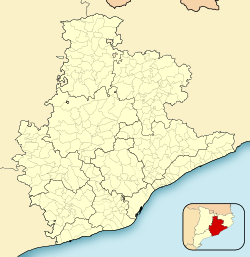Molins de Rei
| Molins de Rei | |||
|---|---|---|---|
| Municipality | |||

Castellciuró Castle.
|
|||
|
|||
| Location in Catalonia | |||
| Coordinates: 41°24′50″N 2°00′57″E / 41.41389°N 2.01583°E | |||
| Country |
|
||
| Community |
|
||
| Province | Barcelona | ||
| Comarca | Baix Llobregat | ||
| Government | |||
| • Mayor | Joan Ramon Casals Matas (2015) | ||
| Area | |||
| • Total | 15.9 km2 (6.1 sq mi) | ||
| Elevation | 37 m (121 ft) | ||
| Population (2014) | |||
| • Total | 25,152 | ||
| • Density | 1,600/km2 (4,100/sq mi) | ||
| Demonym(s) | Molinenc | ||
| Website | www |
||
Molins de Rei (Catalan pronunciation: [muˈɫinz ðə ˈrej]) is a municipality located 18 km from Barcelona's city centre, in the comarca of Baix Llobregat in Catalonia, Spain. It is situated on the left bank of the Llobregat river, on the A-7 autopista from Valencia to La Jonquera and the main N-II road.
Its location has made Molins de Rei a strategic and dynamic municipality, with significant examples of commercial and industrial entrepreneurship.
Its name, Molins de Rei (which means King's Mills), has its origins in the royal windmills that existed in this area, documented as early as 1188. These mills were built by order of the King Alfonso II, and their construction essentially established the municipality. By 1208, a parish and church as well as a cemetery had been built in the town.
In 1309, the town was part of the county of Pallars which belonged to the countess Sibil·la. When she died, the town changed owners to Hugo de Arborea and later on, it was transferred to the convent of Santa Clara in Sardinia (Italy). Again in 1366, the lands were purchased by Berenguer de Relat. In 1430, it was again transferred to Galceran de Requesens i de Santacoloma who built a palace in the village, visited by personalities of the time such as the Catholic Monarchs or Christopher Columbus.
In 1763 a bridge was built to cross the Llobregat river, by order of the King Charles III of Spain. This bridge turned the village into a strategic location during the Peninsular War, and the town was subjected to grave attacks and fires in several occasions. During these attacks, several significant buildings were destroyed, such as the Palace of Requesens.
The Palace of Recasens, ruined by a looting during the 19th century, dates from the 15th century.
...
Wikipedia




